The AMD A10-7700K and AMD A6-7400K CPU Mini-Review
by Ian Cutress on May 27, 2015 9:00 AM ESTGaming Benchmarks
As mentioned previously, this mini-review will focus on a few elements but all our data can be found in Bench, including tests with high end ($300+) graphics cards and some 4K testing.
Alien: Isolation
If first person survival mixed with horror is your sort of thing, then Alien: Isolation, based off of the Alien franchise, should be an interesting title. Developed by The Creative Assembly and released in October 2014, Alien: Isolation has won numerous awards from Game Of The Year to several top 10s/25s and Best Horror titles, ratcheting up over a million sales by February 2015. Alien: Isolation uses a custom built engine which includes dynamic sound effects and should be fully multi-core enabled.
For low end graphics, we test at 720p with Ultra settings, whereas for mid and high range graphics we bump this up to 1080p, taking the average frame rate as our marker with a scripted version of the built-in benchmark.
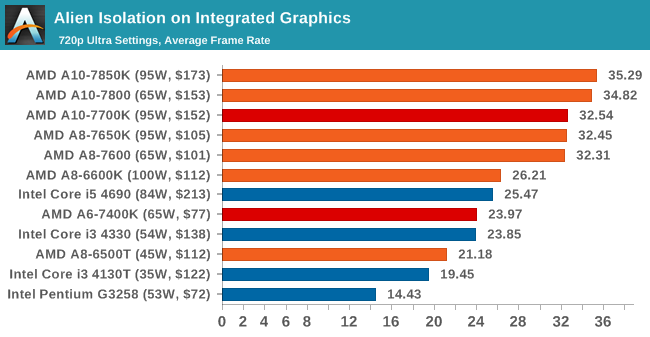
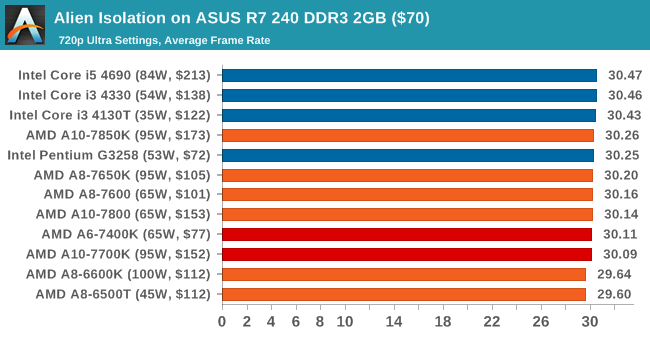
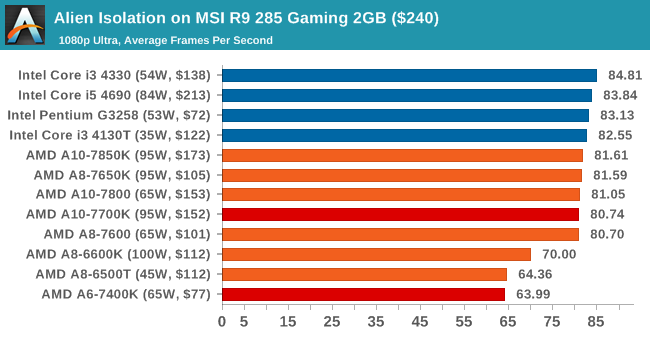
Total War: Attila
The Total War franchise moves on to Attila, another The Creative Assembly development, and is a stand-alone strategy title set in 395AD where the main story line lets the gamer take control of the leader of the Huns in order to conquer parts of the world. Graphically the game can render hundreds/thousands of units on screen at once, all with their individual actions and can put some of the big cards to task.
For low end graphics, we test at 720p with performance settings, recording the average frame rate. With mid and high range graphics, we test at 1080p with the quality setting. In both circumstances, unlimited video memory is enabled and the in-game scripted benchmark is used.
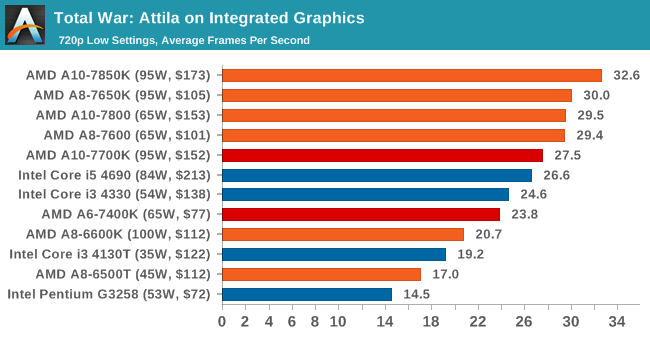
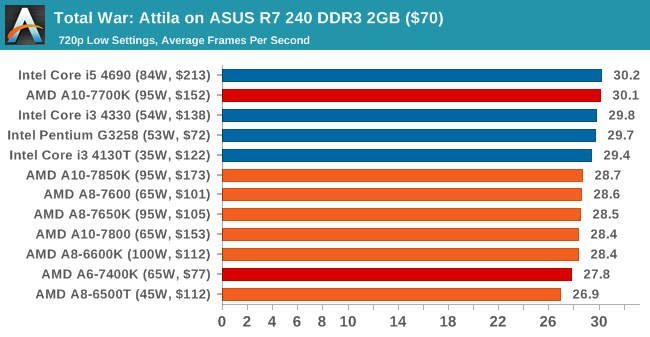
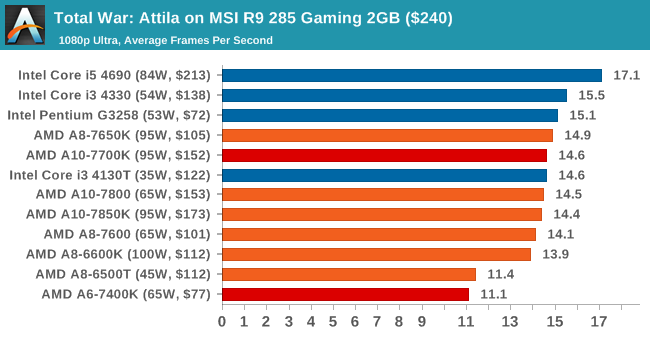
Grand Theft Auto V
The highly anticipated iteration of the Grand Theft Auto franchise finally hit the shelves on April 14th 2015, with both AMD and NVIDIA in tow to help optimize the title. GTA doesn’t provide graphical presets, but opens up the options to users and extends the boundaries by pushing even the hardest systems to the limit using Rockstar’s Advanced Game Engine. Whether the user is flying high in the mountains with long draw distances or dealing with assorted trash in the city, when cranked up to maximum it creates stunning visuals but hard work for both the CPU and the GPU.
For our test we have scripted a version of the in-game benchmark, relying only on the final part which combines a flight scene along with an in-city drive-by followed by a tanker explosion. For low end systems we test at 720p on the lowest settings, whereas mid and high end graphics play at 1080p with very high settings across the board. We record both the average frame rate and the percentage of frames under 60 FPS (16.6ms).

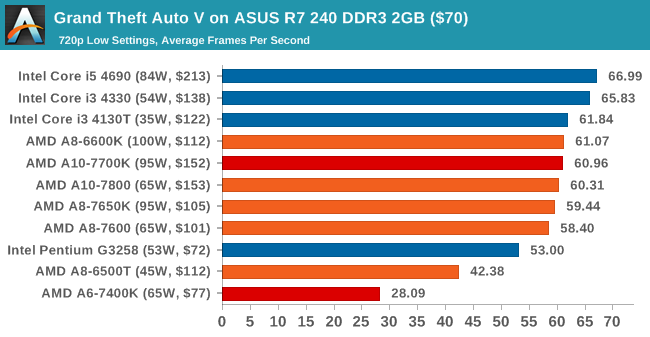
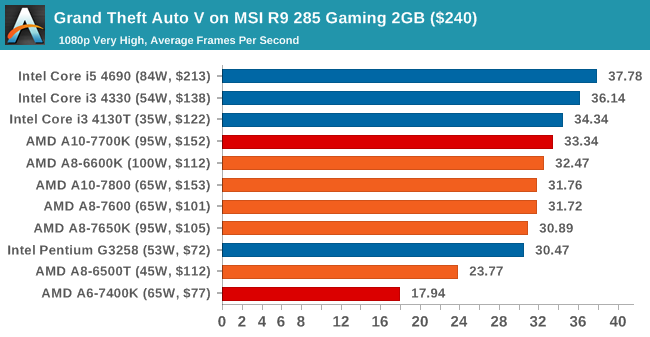
GRID: Autosport
No graphics tests are complete without some input from Codemasters and the EGO engine, which means for this round of testing we point towards GRID: Autosport, the next iteration in the GRID and racing genre. As with our previous racing testing, each update to the engine aims to add in effects, reflections, detail and realism, with Codemasters making ‘authenticity’ a main focal point for this version.
GRID’s benchmark mode is very flexible, and as a result we created a test race using a shortened version of the Red Bull Ring with twelve cars doing two laps. The car is focus starts last and is quite fast, but usually finishes second or third. For low end graphics we test at 1080p medium settings, whereas mid and high end graphics get the full 1080p maximum. Both the average and minimum frame rates are recorded.

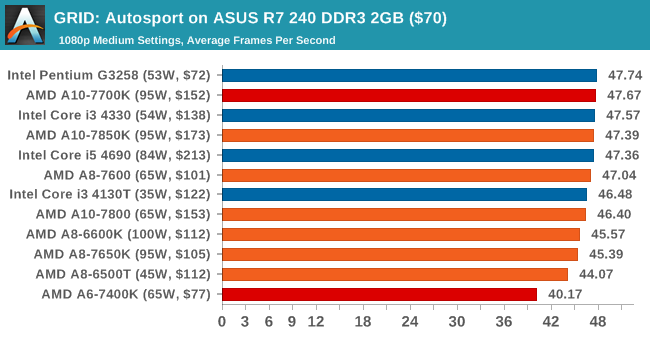
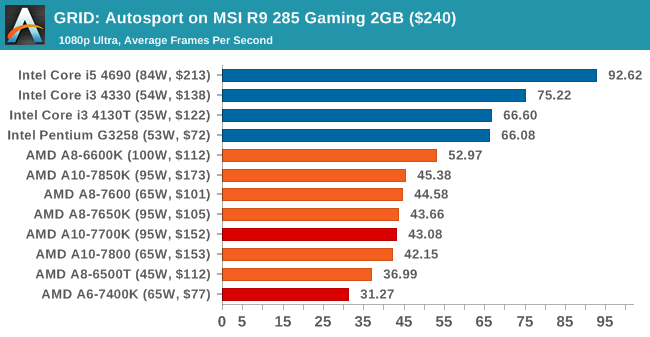
Middle-Earth: Shadows of Mordor
The final title in our testing is another battle of system performance with the open world action-adventure title, Shadows of Mordor. Produced by Monolith using the LithTech Jupiter EX engine and numerous detail add-ons, SoM goes for detail and complexity to a large extent, despite having to be cut down from the original plans. The main story itself was written by the same writer as Red Dead Redemption, and it received Zero Punctuation’s Game of The Year in 2014.
For testing purposes, SoM gives a dynamic screen resolution setting, allowing us to render at high resolutions that are then scaled down to the monitor. As a result, we get several tests using the in-game benchmark. For low end graphics we examine at 720p with low settings, whereas mid and high end graphics get 1080p Ultra. The top graphics test is also redone at 3840x2160, also with Ultra settings, and we also test two cards at 4K where possible.

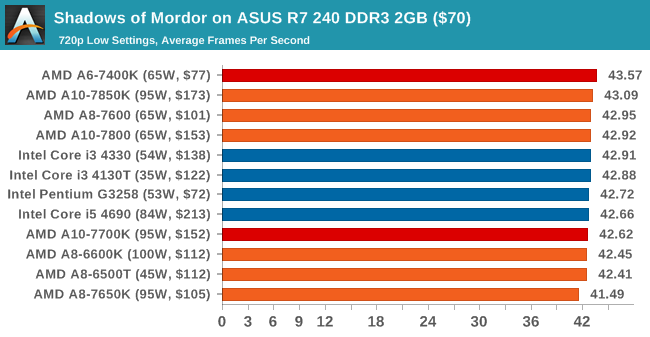
![Shadows of Mordor on MSI R9 285 Gaming 2GB ($240) [Minimum FPS]](https://images.anandtech.com/graphs/graph9287/74558.png)
I added some 4K numbers here, just to see the difference at a higher resolution. It turns out that for average frame rates at least, Shadows of Mordor is CPU agnostic. A fast CPU gets a higher rating in minimum frames however.







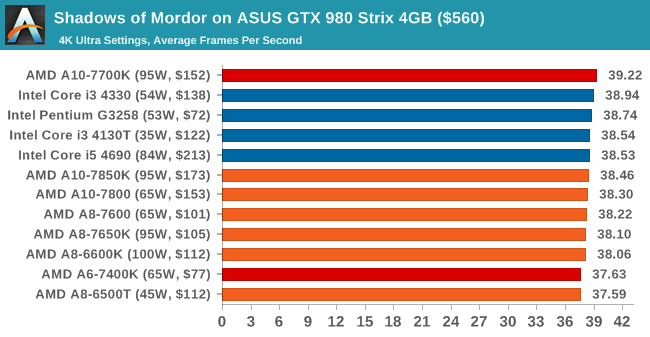
![Shadows of Mordor on ASUS GTX 980 Strix 4GB ($560) [Minimum FPS]](https://images.anandtech.com/graphs/graph9287/74592.png)








105 Comments
View All Comments
testbug00 - Wednesday, May 27, 2015 - link
godavari appears to just be Kaveri 2.0.Like Richland was to Trinity.
Clockspeed bumpbs, perhaps power reduction. No IPC increases.
MrSpadge - Wednesday, May 27, 2015 - link
I wouldn't call it 2.0 if it's just the same chips in different configurations (we should see soon if this is true). It's something they could mostly have done over a year ago.testbug00 - Wednesday, May 27, 2015 - link
It probably is a major stepping revision. Hence, it is a slightly different voltage/etc characteristics, but the same core layout.Edens_Remorse - Wednesday, May 27, 2015 - link
The improvement in stock cooling alone warrants a review. Athlon x4 860k/870k is an absolute gem for gaming. Too bad reviewers give us this year old b.s. knowing full well what is coming tomorrow.just4U - Wednesday, May 27, 2015 - link
I am perfectly ok with Ian reviewing these and getting them into the bench. The A6 part of the review was very welcome and it's nice to know that the A10 is actually more on par with the A8 which makes choices a little easier.A 870 or 860 review with the new coolers though.. hmmm ... "YES!" please do that if you can Ian. I've built a few systems with the 860 and it's crappy cooler.. which does the trick I suppose considering it doesn't run as hot as some of the A8/10s.
Alexvrb - Thursday, May 28, 2015 - link
The more chips that are in Bench the better.As far as coolers go, I will applaud improved coolers but on the other hand... aftermarket cooling is almost a must if you overclock regardless. Doesn't have to be extreme, there's some good budget heatsinks out there.
eanazag - Wednesday, May 27, 2015 - link
When the 7850K was at $178; it was too close to the i5 cores that it made no sense. It is much more competitive at $138. I'd really like to see it at $125.AMD makes sense on IGP only gaming at 720P. Or old games at 1080P.
Refuge - Wednesday, May 27, 2015 - link
Or just lower quality Textures at 1080p (Which makes the bad textures look even worse btw).Its that damn slow memory that hamstrings those iGPU's
Edens_Remorse - Wednesday, May 27, 2015 - link
You can buy the 7850k online today for $125. Cheaper if you live near a Microcenter($119). This "review" is pure b.s.mdriftmeyer - Wednesday, May 27, 2015 - link
Right, because $13 dollars is passed your price range.